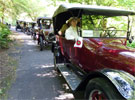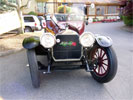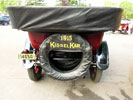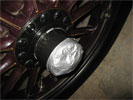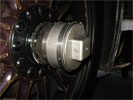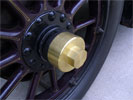
National HCCA Tour—Portland
July 26-30, 2011
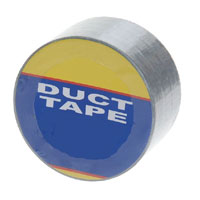 |
| Duct tape is used in emergency roadside repair on the tour. |
Jeanne and Lynn participate with Annie (our 1914 KisselKar 4-40 Touring) in the “Third Time’s A Charm” Tour in Portland. This is the third time that Portland is hosting the tour, each offering separated by 20 years. At the banquet at the end of the third day of touring, they applaud the dozen or so drivers that had participated in all three tours. Some had used the same car in all three tours!
 |
|||||||
A boy and his grandfather enjoy an cool treat. |
|||||||
There are many remarkable sights and experiences on the tour. One is the multiple three-generation touring families that participate. Another is the number of women and men that dress so beautifully in period costumes.
Other BAHCC members that the Kissels recognized on the tour are Johnny and Chris Crowell with their 1914 Simplex, Johnny's brother Wes, John and Carol O’Neill with their 1913 Apperson, and Fred and Nancy Byl with their 1915 Ford. The O’Neill’s receive the 1913-and-later people’s choice award at the banquet for their wonderful 1913 Apperson 4-55 “Jack Rabbit” Touring.
Glenn and Shirley Slack, organizers of the tour with the Portland Regional Group, are friends and owners of a beautiful 1915 KisselKar 6-42 7-passenger Touring. Under normal circumstances it would be reasonably unusual to find two KisselKars on an HCCA tour as there are only 34 pre-16 KisselKar cars know to exist in the world. On this tour there are no less than *three* as Bob and Nancy Ullrich bring their handsome 1910 KisselKar 4-50 Toy Tonneau.
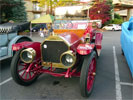 |
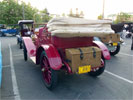 |
||||||
| It's a THREE KisselKar tour. Here's two shots of Bob Ullrich's 1910 KisselKar Toy Tonneau. | |||||||
Arriving in Portland, one could not help but be impressed with the high level of organization and large number of volunteers helping with the HCCA tour. Upon arrival with their Excursion towing their enclosed car trailer, volunteers direct the Lynn and Jeanne to the ample space provided for trailer parking. After unloading Annie, she is parked with many of the other 92 cars that are signed up for the tour.
The tour has three days of active driving plus two half days before and after for socializing. Participants are encouraged to arrive early, or stay late and enjoy many side attractions that are documented in a wonderful newsletter-style publication that was distributed a month or so before the tour.
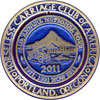 |
|||||||
| Participants receive a handsome, brass medallion. | |||||||
The tour booklet and materials received at registration are another marvel. The booklet with clear schedules, directions, graphics and text describing the significance of sites visited is printed on glossy paper and professionally prepared. A cast 3” brass medallion is a welcome keepsake. The tour is incredibly well planned and it runs as smooth as silk, although the organizers likely confront may challenges behind the scenes.
 |
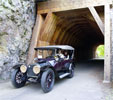 |
 |
||||||
| Jeanne pictured at Multnomah Falls (left). Annie emerges from a tunnel (center). Jeanne and Wade Smith pose with Jeanne and Annie (right). | ||||||||
The first days tour is a 75 mile drive along the scenic Columbia River. Stopping at Vista House, an octagonal stone structure built in 1916-18 as a memorial to Oregon pioneers and perched 733 feet above the river, the tour has spectacular views of the valley cut by the river. Later they visit 620’ Multnomah Falls then drive on to Rooster Rock State Park for lunch.
There are many disabled horseless carriages along the route, keeping the three trouble trucks very busy. Lynn is somewhat surprised by the number he sees experiencing difficulty and wonders if this is unusual for a national tour.
Lynn and Jeanne Kissel are fortunate to have Wade and Jeanne Smith as passengers on all three days of the tour. Hailing from San Antonio, Texas, they are great companions, as they are witty and entertaining. By day two, Wade is sitting in the front with Lynn and the two Jeannes shared the rear seat so that the boys and girls can carry on separate conversations with minimal interference.
 |
|||||||
| Horseless carriages on Mount Hood | |||||||
On day two they travel over 140 miles and climb to the 6000’ level on Mount Hood, an 11,239’ snow-capped peak that is the tallest in Oregon. At the destination awaits a great lunch at the Timberline Lodge, built in the 1930s on the south side of the stratovolcano. (Also known as a composite volcano, it is a tall cone built up of many layers of hardened lava, pumice and ash. Unlike shield volcanoes, stratovolcanoes have a steep profile and periodic explosive eruptions – think Mount St. Helens.)
Many of the cars have trouble with the climb up Mount Hood and Annie is not immune. Although Lynn had relocated and insulated the fuel line a week before the tour, Annie suffers mild to moderate symptoms of vapor lock as witnessed by the boiling fuel seen in the glass bowl of her Stromberg carburetor. Letting things cool down by sitting at the side of the road for 5 minutes is enough to allow the Kissels to complete the trip up the mountain.
As they near Portland on the return trip, Lynn hears a distinct metallic “tink” from under the car reflected off a guard rail that the car is passing. Noting a loss of drive power to the rear wheels, he coasts to a stop on the shoulder of the road to find that the right rear hubcap (which retains the drive axle in Annie’s full floating rear end) has gone missing; the axle has disengaged and is protruding a couple of inches out from the wheel. The “tink” was likely the disengagement of the interlocking axle/wheel cogs. Although they spent hours on two days looking, they can not find the hubcap. Perhaps it jumped ship many miles before the axle disengaged or was simply hiding under a bush somewhere.
As it is starting to get late in the day, they decide to call for a trouble truck. Adding to their concern, all the trucks are engaged helping other stranded motorists and none are available to come to their aid. To complicate matters, the drawbridge on I-5 that they need to cross to return to their hotel is stuck in the open position and a major traffic jam has resulted. Yikes! Even if they could move, we would just be stalled in traffic.
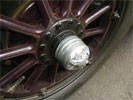 |
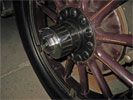 |
|||||||
| Lynn's temporary repair (left) and Annie's remaining original hubcap (right) for comparison. | ||||||||
In desperation Lynn uses duct tape from his emergency kit to reconnect the axle, not sure that the temporary repair will actually work. He turns the car around and drives the short distance to Salty’s, a delightful local restaurant. Cocktails and dinner at a popular local establishment is not a bad way to weather a breakdown and wait for the epic traffic jam to clear. Later as darkness falls, he drives the duct-taped car with lights on the several miles to their hotel. Much to his surprise and delight the duct tape holds. It does not even hint at failing, neither stretching nor tearing. Apparently Red Green’s faith in the power of duct tape is well placed. (See, for example, the Canadian television comedy series The Red Green Show and the low-budget movie Duct Tape Forever, 2002.)
Lynn spends a restless night after the hubcap troubles from the day before, and frequently awakes to consider if he should attempt the last days drive with the compromised Kissel. Sometime after midnight he concludes that he should err on the cautious side and not attempt the third days drive.
Yet, when he awakes in the morning he fells brave and has a change of heart. Finding a nearby Home Depot with his smart phone, Lynn drives Annie to the hardware store and buys fresh duct tape (two rolls, one in silver and one in black, plus a roll of tie wire in case something stronger is needed). Several employees pour out of the store into the parking lot to inspect the car and discuss and laugh about the duct-tape repair. After returning to the tour hotel, Lynn retapes the axle, using the two color tapes to mimic the black hub and silver cap, appealing to his warped sense of being clever.
Our third days drive is over 50 miles and takes them to historic Fort Vancouver and lunch at Alderbrook Park. Fort Vancouver was established in the 1824 by the Hudson’s Bay Company and ultimately greatly contributed to American settlement of the Pacific Northwest. At Alderbrook Park cars, drivers and passengers participate in several car games. In one game, a blind-folded driver navigates an obstacle course based on instructions from the passenger. In another, the car drives past buckets of potatoes and the passenger attempts to gather as many as possible using a long stick with a spike at the end. Great fun is had by all.
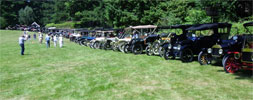 |
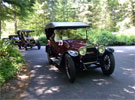 |
 |
|||||
| Pictures of cars on the third day of touring | |||||||
The third days drive features steep rolling hills, one or two so steep that Annie needs to take them in 1st gear. Lynn is really worried about it then, but the miracle tape doesn't’t fail him.
 |
 |
||||||
| There are many beautifully dressed people on the tour (left). Chris Crowell shows Jeanne her period suit (right). | |||||||
The last seven miles of the day are spent on a limited access highway in Friday afternoon traffic. Wade, sitting in the front seat, says that Annie hit 55 MPH according to the speedometer. This is no mean feat for the little 40-HP car with four, mature, well-fed passengers and her top up. Wade also says that he mentally reviewed all of the prayers that he learned as a youth. Jeanne Kissel sticks her head out several times to inspect the state of the duct tape. Whether it was the power of prayer or simply the power of duct tape, the Kissels and the Smiths all arrive safely home without incident. The tape is in perfect condition and does not appear to be the least bit stressed by the day of hard driving.
By the end of the Portland tour, Lynn starts telling people that the only reason Kissel used metal hubcaps rather than duct tape to retain the axles on its cars was that duct tape hadn't’t been invented, yet.
Annie is driven around Livermore in the weeks after the Portland tour, still using the duct tape to retain her axle. In the days before the August 13 BAHCC S.A.S (Seeing Alameda Slowly) Tour, Lynn replaces the duct tape with a more substantial steel reinforced 4” rubber coupler and ABS end cap made for sewer lines. While it seems like a somewhat more robust but still temporary repair, it works just as well as the duct tape for the 70-mile round-trip drive to Alameda from Livermore.
In subsequent weeks, a permanent replacement cap is machined from brass. Lynn thinks that this replacement will be virtually indistinguishable from the original once a small casting is added of the KisselKar script from the end of the original hubcap and the assembly is plated. One can wonder how soon, if ever, Lynn completes these final steps.
Based on a suggestion that he received from a fellow horseless carriage owner, Lynn now uses a light bead of silcone gasket maker when he screws the hubcaps on the car. Separately he has seen this tech article on the national HCCA site with similar advice about protecting screw-on hubcaps.
![]()
Contact  with your comments or questions
with your comments or questions
Copyright © 2018 Lynn Kissel
Last updated: Oct. 11, 2011

